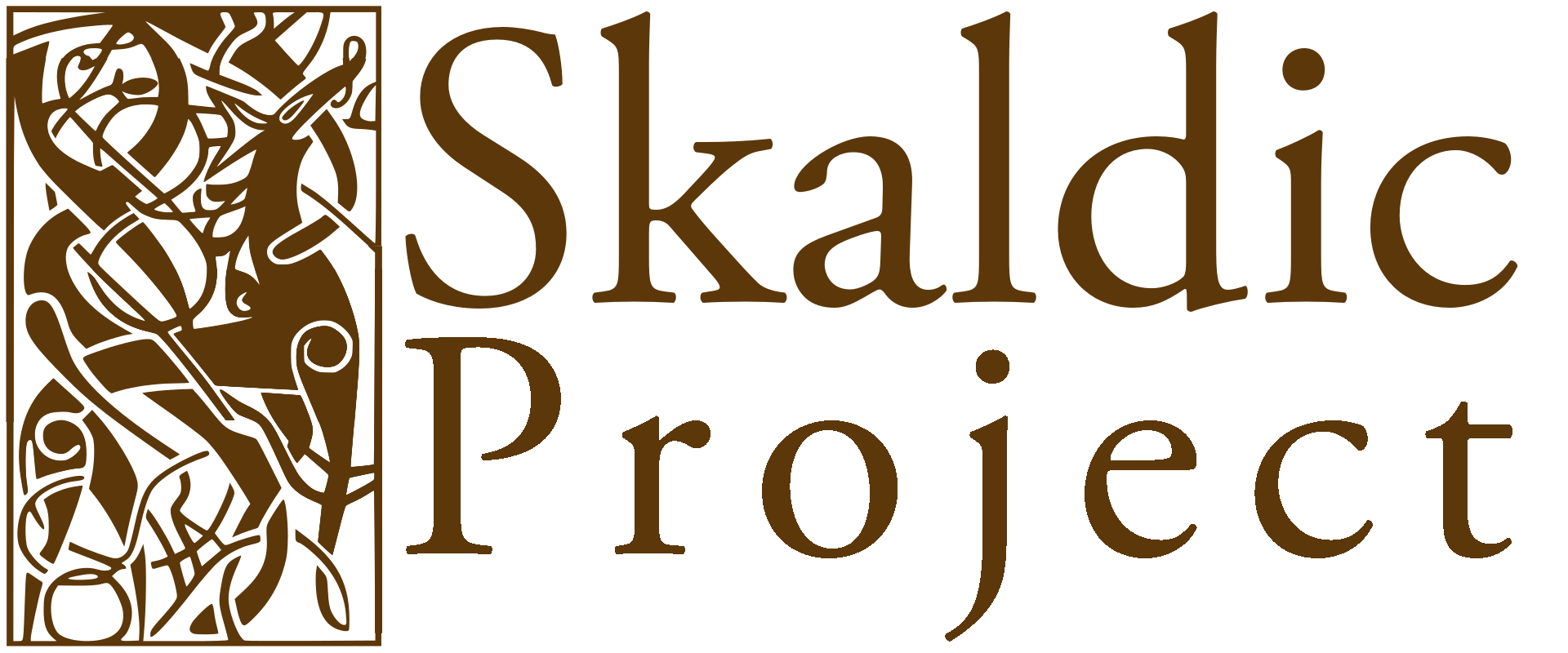Gusi Lv 4VIII (Ket 8)
Beatrice La Farge (ed.) 2017, ‘Ketils saga hœngs 8 (Gusi finnakonungr, Lausavísur 4)’ in Margaret Clunies Ross (ed.), Poetry in fornaldarsögur. Skaldic Poetry of the Scandinavian Middle Ages 8. Turnhout: Brepols, p. 559.
Búztu nú við bitri eggþrumu;
hafþu hlíf fyr þér; hart mun ek skjóta.
Þér mun ek brálla at bana verða,
nema þú af auði öllum látir.
Búztu nú við {bitri eggþrumu}; hafþu hlíf fyr þér; ek mun skjóta hart. Ek mun verða þér brálla at bana, nema þú látir af öllum auði.
Prepare yourself now for {the bitter blade-thunder} [BATTLE]; have a shield before you; I will shoot hard. I will quickly be the death of you, unless you give up your entire wealth.
Mss: 343a(55v), 471(52r) (Ket)
Readings: [1] við: ef þú vilt 471 [2] bitri eggþrumu: brátt við eggþrumu 471 [5] brálla: bráðla 471
Editions: Skj AII, 280, Skj BII, 302, Skald II, 160, NN §2391; FSN 2, 120, FSGJ 2, 162, Anderson 1990, 48, 91, 434; Edd. Min. 7.
Context: This stanza is introduced by the words: Gusir kvað ‘Gusir spoke’ immediately after Ket 7.
Notes: [1-2]: Kock (Skald; NN §2391) adopts the reading of 471 for these two lines. — [2] eggþrumu ‘blade-thunder [BATTLE]’: The cpd eggþruma is a hap. leg, but it has a close parallel and synonym in eggþrima (LP: eggþrima, 2. egg and egg-, 2. þruma); both egg ‘cutting edge, blade’ and þruma ‘thunder, noise’ are well-attested as determinant and base-word respectively of kennings for ‘battle’. Cf. Ket 4/6 and Note. — [7-8] öllum auði ‘your entire wealth’: The ‘wealth’ mentioned here and in the next three stanzas is evidently a reference to the riches Ketill will inherit from his father.
References
- Bibliography
- FSN = Rafn, Carl Christian, ed. 1829-30. Fornaldar sögur nordrlanda. 3 vols. Copenhagen: Popp.
- Skald = Kock, Ernst Albin, ed. 1946-50. Den norsk-isländska skaldediktningen. 2 vols. Lund: Gleerup.
- NN = Kock, Ernst Albin. 1923-44. Notationes Norrœnæ: Anteckningar till Edda och skaldediktning. Lunds Universitets årsskrift new ser. 1. 28 vols. Lund: Gleerup.
- LP = Finnur Jónsson, ed. 1931. Lexicon poeticum antiquæ linguæ septentrionalis: Ordbog over det norsk-islandske skjaldesprog oprindelig forfattet af Sveinbjörn Egilsson. 2nd edn. Copenhagen: Møller.
- FSGJ = Guðni Jónsson, ed. 1954. Fornaldar sögur norðurlanda. 4 vols. [Reykjavík]: Íslendingasagnaútgáfan.
- Edd. Min. = Heusler, Andreas and Wilhelm Ranisch, eds. 1903. Eddica Minora: Dichtungen eddischer Art aus den Fornaldarsögur und anderen Prosawerken. Dortmund: Ruhfus. Rpt. Darmstadt: Wissenschaftliche Buchgesellschaft.
- Anderson, Sarah M. 1990. ‘The Textual Transmission of Two Fornaldarsögur: Ketils saga høings and Gríms saga loðinkinna’. Ph.D. thesis. Cornell University…
- Internal references
- Beatrice La Farge (ed.) 2017, ‘Ketils saga hœngs 4 (Gusi finnakonungr, Lausavísur 2)’ in Margaret Clunies Ross (ed.), Poetry in fornaldarsögur. Skaldic Poetry of the Scandinavian Middle Ages 8. Turnhout: Brepols, p. 555.
- Beatrice La Farge (ed.) 2017, ‘Ketils saga hœngs 7 (Ketill hœngr, Lausavísur 4)’ in Margaret Clunies Ross (ed.), Poetry in fornaldarsögur. Skaldic Poetry of the Scandinavian Middle Ages 8. Turnhout: Brepols, p. 558.
Stanza/chapter/text segment
Use the buttons at the top of the page to navigate between stanzas in a poem.
Information tab
- text: if the stanza has been published, the edited text of the stanza and translation are here; if it hasn't been published an old edition (usually Skj) is given for reference
- sources: a list of the manuscripts or inscriptions containing this stanza, with page and line references and links (eye button) to images where available, and transcription where available
- readings: a list of variant manuscript readings of words in the main text
- editions and texts: a list of editions of the stanza with links to the bibliography; and a list of prose works in which the stanza occurs, allowing you to navigate within the prose context
- notes and context: notes not linked to individual words are given here, along with the account of the prose context for the stanza, where relevant
Interactive tab
The text and translation are given here, with buttons to toggle whether the text is shown in the verse order or prose word order. Clicking on indiviudal words gives dictionary links, variant readings, kennings and notes, where relevant.
Full text tab
This is the text of the edition in a similar format to how the edition appears in the printed volumes.
Chapter/text segment
This view is also used for chapters and other text segments. Not all the headings shown are relevant to such sections.
